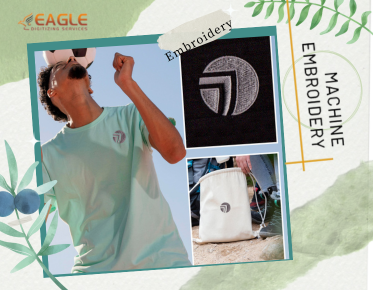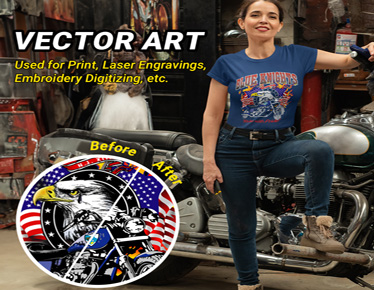Choosing the Right Stabilizers: A Game-Changer for Projects
When it comes to crafting
and sewing, choosing the right stabilizers can make all the difference in the
success of your projects. With so many options available, it can be
overwhelming to determine which stabilizer will provide the best support for
your fabric and design. In this article, we’ll break down the various types of
stabilizers and their specific uses, helping you make informed decisions for
your projects. Whether you’re embroidering, quilting, or sewing, these tips
will ensure your creations come out looking professional and polished! Here are Some Points You Should Be Aware of
Regarding Embroidery Digitizing!
The Role of Stabilizers in Different
Types of Projects
In a world filled
with fabrics and fibers, stabilizers are tailored for a multitude of
applications. For embroidery, they provide the
support necessary to keep stitches uniform and well-defined. In quilting, they
help prevent the fabric from shifting, resulting in precise piecing. For
garment construction, stabilizers can bolster necklines and armholes, ensuring
a clean finish. Understanding the specific role of stabilizers in your project
type can significantly elevate the quality of your work.
Types of Stabilizers: An
Overview
Exploring
the Different Categories of Stabilizers
Stabilizers come
in various forms, each designed to serve distinct purposes. Broadly
categorized, they can be divided into tear-away, cut-away, water-soluble,
sticky, and fusible stabilizers. Each type has unique properties and is suited
for different fabrics and techniques. Familiarity with these categories is
vital for making informed decisions that will enhance the overall quality of
your projects.
How
to Choose Based on Fabric and Project Type
Choosing the right stabilizer involves understanding both your fabric and the project at hand. Lightweight, sheer fabrics may require a soft, tear-away stabilizer to maintain their delicate nature, while heavier fabrics may benefit from cut-away stabilizers for added support. Consider the stitch density and complexity of your design; intricate patterns may necessitate more robust stabilization to prevent distortion. By matching your stabilizer choice to the specific characteristics of your fabric and project, you can ensure optimal results.
Tear-Away Stabilizers
What
Are Tear-Away Stabilizers?
Tear-away
stabilizers are temporary solutions that provide support during stitching but
are designed to be easily removed afterward. Typically made from non-woven
materials, they are lightweight and work wonders with stable fabrics. Once the
stitching is complete, you can simply tear away the excess, leaving behind a
clean finish. This makes them a favorite among crafters who want minimal fuss
and maximum impact.
When
and Why to Use Tear-Away Stabilizers
Tear-away
stabilizers shine when used with tightly woven fabrics and simple designs. They
are ideal for projects where you want to maintain a soft hand feel, such as
t-shirts or linens. Use them when the design doesn’t require much manipulation
after stitching, as they can easily be removed without leaving residue. Their
simplicity and effectiveness make them a staple in any crafter’s toolkit.
Cut-Away Stabilizers
Understanding
Cut-Away Stabilizers: Benefits and Uses
Cut-away
stabilizers are the heavyweights of the stabilizer world, offering unparalleled
support for embroidery designs. Made from sturdy, woven materials, these
stabilizers remain in place even after stitching. They are particularly
beneficial for projects involving knit fabrics or heavy stitching, as they
prevent distortion and help maintain the integrity of the design.
When
to Opt for Cut-Away Stabilizers Over Others
Choose cut-away
stabilizers for projects that involve intricateembroidery or stretchy fabrics, like t-shirts or sweatshirts. They
provide the firmness needed to keep the fabric from stretching during and after
the stitching process. If you’re working with designs that require extensive
stitching, cut-away stabilizers are your go-to choice, ensuring your
masterpiece retains its shape.
Water-Soluble Stabilizers
What
Are Water-Soluble Stabilizers?
Water-soluble
stabilizers dissolve in water, making them perfect for delicate or intricate
projects. They come in various forms, including sheets and sprays, and are
especially valuable for projects requiring fine detail or when working with
sheer fabrics. The beauty of water-soluble stabilizers lies in their ability to
provide support without leaving a trace.
Perfect
Projects for Water-Soluble Stabilizers
These stabilizers
are ideal for lacework, freestanding embroidery,
or any project where you want to minimize bulk. They work wonders in creating
intricate designs on sheer fabrics, allowing for beautiful results without the
added weight of traditional stabilizers. Whether crafting delicate lace or
enhancing the detail of floral embroidery, water-soluble stabilizers deliver
stunning effects.
Sticky Stabilizers
The
Convenience of Sticky Stabilizers
Sticky
stabilizers, as the name implies, come with an adhesive backing that provides
convenience and ease during the stitching process. These stabilizers can be particularly
beneficial for fabric that’s difficult to hoop, such as leather or felt. By
adhering directly to the fabric, they ensure stability without the need for
cumbersome clamps or pins.
Best
Practices for Using Sticky Stabilizers in Your Work
When using sticky
stabilizers, ensure that the adhesive is compatible with your fabric type. It’s
advisable to test the adhesive on a scrap piece to prevent any unwanted
residue. For best results, use a sharp needle to prevent any snags and maintain
smooth stitching. By following these best practices, you can leverage the full
potential of sticky stabilizers for your projects.
Fusible Stabilizers
Understanding
Fusible Stabilizers and Their Applications
Fusible
stabilizers come equipped with an adhesive backing that bonds to the fabric
when heated with an iron. They provide exceptional support for a variety of
fabrics while remaining permanently attached. This versatility makes them a
favorite for garment construction, appliqué, and quilting, ensuring a stable
foundation.
How
to Properly Apply Fusible Stabilizers for Best Results
To apply fusible stabilizers effectively, start by preheating your iron. Lay the stabilizer on the wrong side of your fabric, and cover it with a pressing cloth. Press down for a few seconds, ensuring the heat penetrates the stabilizer. Allow it to cool before proceeding with your project. Proper application will enhance the performance of your fusible stabilizer, giving you a reliable foundation for your designs.
Choosing Stabilizers for
Different Fabrics
Matching
Stabilizers to Your Fabric Type
Different fabrics
require different stabilizers for optimal results. Delicate fabrics such as
silk or chiffon often pair well with lightweight tear-away or water-soluble
stabilizers, ensuring a gentle touch. Conversely, heavy fabrics like denim or
canvas may necessitate the robustness of cut-away stabilizers to prevent
distortion during the stitching process.
How
Fabric Weight and Stretch Affect Your Choice
Fabric weight and
stretch are critical factors when selecting a stabilizer. Lightweight, stretchy
fabrics benefit from soft, flexible stabilizers that allow for movement, while
heavy, stable fabrics require more substantial support. Understanding these
characteristics will enable you to make informed choices that lead to
successful outcomes in your projects.
Considering Project Complexity
Simple
vs. Complex Projects: Choosing the Right Stabilizer
The complexity of
your project plays a significant role in stabilizer selection. For simple
designs with minimal stitching, a tear-away
stabilizer may suffice. However, for intricate patterns or multiple layers, opt
for cut-away or fusible stabilizers to ensure everything stays in place.
Tailoring your choice based on project complexity will enhance the quality and
finish of your work.
How
to Adjust Your Stabilizer Choice Based on Project Details
Consider factors
such as stitch density, fabric type, and design intricacy when adjusting your
stabilizer choice. High-density designs typically require more robust support,
while low-density patterns can often work with lighter stabilizers. By
evaluating these details, you can refine your stabilizer selection for the best
possible results.
Layering Stabilizers
Combining
Different Stabilizers for Optimal Results
Layering
stabilizers can be an effective strategy for achieving optimal results in
complex projects. By combining different types, you can enhance stability and
support where needed. For instance, a tear-away stabilizer can be layered over
a cut-away stabilizer to provide additional support while still allowing for
easy removal.
How
to Layer Stabilizers for Enhanced Stability
When layering
stabilizers, start by placing the most robust stabilizer closest to the fabric.
Next, add the lighter stabilizer on top, ensuring they adhere well together.
This technique allows you to capitalize on the strengths of each stabilizer
while minimizing their individual weaknesses, resulting in a balanced and
effective support system for your project.
Testing Stabilizers Before Use
The
Importance of Sample Testing with Stabilizers
Before diving
into a project, conducting sample tests with stabilizers is crucial. Testing
allows you to evaluate how the stabilizer interacts with your fabric and
design, ensuring compatibility and effectiveness. This step is essential for
avoiding costly mistakes and ensuring the integrity of your final product.
How
to Conduct Effective Stabilizer Tests
To conduct an
effective stabilizer test, cut a small piece of your fabric and apply the
stabilizer as you would in the final project. Stitch asample design and observe how the stabilizer performs. Pay attention to
stitch definition, fabric distortion, and ease of removal. This trial-and-error
process will provide invaluable insights, enabling you to choose the most
suitable stabilizer for your needs.
How to Prepare Your Fabric for
Stabilization
Prepping
Fabric: Steps to Take Before Applying Stabilizers
Preparing your
fabric before applying stabilizers is essential for achieving the best results.
Begin by washing and ironing your fabric to remove any sizing or dirt that may
interfere with adhesion. Pressing the fabric also ensures it lies flat, making
it easier to apply stabilizers uniformly.
The
Impact of Pre-Washing and Ironing on Stabilizer Performance
Pre-washing fabric can significantly affect stabilizer performance. Fabrics can shrink or distort after washing, so it’s wise to pre-wash before applying stabilizers. Ironing ensures the fabric is smooth and free of wrinkles, providing an ideal surface for stabilization. These preparatory steps lay a strong foundation for your project, leading to cleaner, more professional results.
Troubleshooting Common Stabilizer
Issues
Identifying
Problems with Stabilizers and How to Fix Them
Even the most
seasoned crafters encounter issues with stabilizers. Common problems include
puckering, residue left on fabric, or stabilizers not adhering properly.
Finding practical remedies requires determining the underlying reason. For
puckering, ensure you’re using the appropriate stabilizer for your fabric type.
If residue is an issue, consider switching to a water-soluble or lighter
stabilizer.
Tips
for Preventing Common Stabilizer Mishaps
Preventing
stabilizer mishaps begins with thorough testing and preparation. Always sample your stabilizer with the fabric to ensure compatibility, and keep your
workspace clean to avoid contamination. Properly applying and storing
stabilizers will also extend their lifespan and effectiveness, minimizing the
risk of issues during your projects.
The world of
stabilizers is vast, and experimentation is key to discovering what works best
for you. Don’t hesitate to try new types and techniques. Each project is an
opportunity to learn and grow as a creator. Embrace the journey, and soon
enough, you’ll find your perfect stabilizer match, transforming your crafting
experience into one of confidence and creativity.



